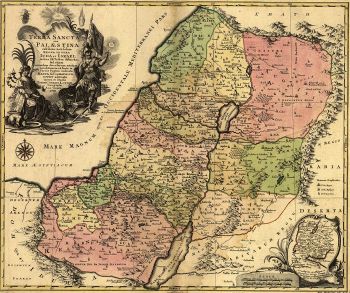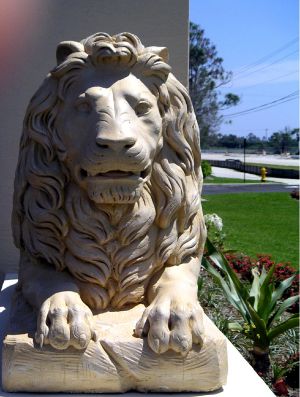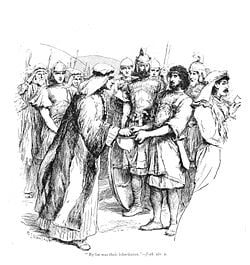Tribe of Judah
The Tribe of Judah ( Standard Hebrew Yəhuda, "Praise") is one of the Hebrew tribes, founded by Judah, son of Jacob.
The tribe of Judah was allotted the southernmost area of Canaan after its conquest by the Israelites. It became both the most powerful and the most important of the tribes. From this tribe came the great kings David and Solomon and all of the kingd recognized by the Bible as good. As a lineal descendant of David, the Messiah, too, would be a Judahite.
Together with the Tribe of Benjamin and elements of the Tribe of Levi, the descendants of Judah eventually formed the southern Kingdom of Judah in the ancient Land of Israel. The Judahites were not carried into captivity and "lost" with the ten tribes of the northern Kingdom of Israel when it fell to the Assyrians in the seventh century B.C.E. Instead, the people of Judah were exiled to Babylon about 586, but were eventually able to return and rebuild their nation. In time, the tribe of Judah became identified with the entire Hebrew nation and gave its name to the people known today as the Jews.
In the Bible
Origins
The tribe of Judah descended from the patriarch Judah, the fourth son of Jacob and Leah (Gen. 29:35). Judah's daughter-in-law Tamar played a pivotal role in ensuring the survival of Judah's lineage, giving birth the the twins Peres and Zerah. Later, Judah and his sons went down with Jacob into Ancient Egypt (Gen. 46:12; Ex. 1:2). On his deathbed, Jacob prophesied that Judah would be the leader and ruler of his brothers:
- Judah, your brothers will praise you;
- your hand will be on the neck of your enemies;
- your father's sons will bow down to you.
- You are a lion's cub, O Judah...
- The scepter will not depart from Judah,
- nor the ruler's staff from between his feet,
- until he comes to whom it belongs
- and the obedience of the nations is his. (Genesis 49:8-10 )
Exodus and Conquest
By the time of the Exodus the tribe of Judah had reortedly increased to the number of 74,000 males. (Num. 1:26, 27) The clans which then composed the tribe are said to have been the Shelanites, Perizzites, Zerahites, Hezronites, and Hamulites. (Num. 26:19-22) Judah marched at the van on the east of the Tabernacle (Num. 2:3-9; 10:14); its standard, as is supposed, being a lion's whelp.
Caleb, the son of Jephunneh, represented the tribe as one of the twelve spies sent to gather intelligence in Canaan, (13:6; 34:19) being the only one other than Joshua to deliver a faithful report. Under Caleb, during the wars of conquest, Judah conquered that portion of the country which was later assigned to it as its inheritance. (Josh. 14:6-15; 15:13-19).
The inheritance of the tribe of Judah was at first fully one-third of the whole country west of the Jordan River, in all about 2,300 square miles. (Josh. 15) However, a later distribution gave Simeon about 1,000 square miles out of the portion of Judah. (Josh. 19:9) That which remained to Judah was still very large in proportion to the inheritance of the other tribes.
The boundaries of the territory are described in Josh. 15:20-63. It is said to have extended south as far as Kadesh Barnea, about 50 miles south of Beersheba, and west as far as Gaza, Ashdod, and Ekron. Even after the supposed conquest, this allotted Judah a terriority that included lands and fortified cities still under control of the Philistines, Jebusites, and other Canaanite peoples, with whom they would struggle for centuries.
Period of Judges
Judah is said to have been the first tribe to successfully attack the Canaanites after the death of Joshua. However, its triumphs described in the first chapter of the Book of Judges — including the Philistine cities of Gaza, Ashdod, and Ekron as well as the Jebusite city of Jerusalem — appear to be either exaggerated or shortlived. Judges 15 describes a situation in which the men of Judah admits that "the Philistines are rulers over us," and Judges 1 makes it clear that Jerusalem was not successfully captured.
From the Book of Judges (1:16) it is learned that the non-Israelite people known as the Kenites united with Judah and apparenetly became a clan of the tribe.
Judah is not mentioned in the song of Deborah (Judges 5) among the tribes who joined in that war. Judah also cooperated with its Phlistine overlords in the attempted capture of the judge Samson, a member of the tribe of Dan. (Judges 15) Indeed, none of the biblical judges are from from Judah. However, Judah joins with the other tribes and takes the lead in punishing Benjamin for is sin in regard to the affair of the Levite's concubine. (Judges 18-19)
The "United" Kingdom
In the accounts of the kingdom of Saul, Judah has developed a very distinct identify from the other tribes (I Sam. 9:8, 17:52, 18:16). After Saul's death, David established a separate Kingdom of Judah (II Sam. 2:1) while the norhter tribes remained loyal to the hous of Saul under his heir, Ish-bosheth. After seven and one-half years, with the defeat of Ish-bosheth, Judah and Israel were under David's kingship. Although several rebellions arose, this union continued for 80 years, through the reign of King Solomon. After the division of Israel and Judah under Rehoboam and Jeroboam I repectively, the history of the tribe of Judah becomes fused with that of the Kingdom of Judah itself.
Legacy
While the northern tribes were effectively scattered and "lost" after the Assyrian conquest of the Kingdom of Israel in -------, the Judahites were able to maintain their ethnic and cultural identity after being exiled to Babylon under Nebechadrezzar II of Babylon in 587. Under Cyrus the Great of Persia, many returned to Jerusalem, rebuilt the Temple and established a national identity as "Jews" which has lasted until this day. The northern tribes reconstituted to some degree in Samaria, but were denigrated by the Jews for intermarrying with foreign peoples and for worshiping outside of Jerusalem at Mt. Gerezim. Whatever remained of the northern tribes eventually became know either as the "Samaritans" or were simply considered to be "lost."
Most Jews today consider themselves as descendants of the tribe of Judah. Some do claim membership in the Levites, the priestly clan that — like other Jews — was exiled to Babylon and returned to rebuild the Temple. Jews with family names such as Benjamin, Naphtali, Asher, etc. usually are unable to trace their genealogies back to these historical tribes.
Notable members
- Judah, Biblical eponymous ancestor of the tribe
- Perez, his son.
- Caleb, military leader from the time of the Exodus, and his brother Kenaz.
- Othniel, leader from the period of the judges and son of Kenaz.
- Boaz, Obed, and Jesse, the great-grandfather, grandfather and father, respectively, of King David.
- David, king of Israel and founder of the Davidic line.
- The Kings of Judah who were descended from David.
- The prophets Amos, Habakkuk, Isaiah, Jeremiah, Joel, Micah, Obadiah, Zechariah, and Zephaniah.
- Shealtiel and Zerubabel, figures of the Babylonian Exile.
- Nehemiah, governor of Judea under the Persian Empire.
- The Exilarchs and the great teachers of the House of Hillel.
- Jesus Christ according to the genealogy of Matthew 1:1
Credits
New World Encyclopedia writers and editors rewrote and completed the Wikipedia article in accordance with New World Encyclopedia standards. This article abides by terms of the Creative Commons CC-by-sa 3.0 License (CC-by-sa), which may be used and disseminated with proper attribution. Credit is due under the terms of this license that can reference both the New World Encyclopedia contributors and the selfless volunteer contributors of the Wikimedia Foundation. To cite this article click here for a list of acceptable citing formats.The history of earlier contributions by wikipedians is accessible to researchers here:
The history of this article since it was imported to New World Encyclopedia:
Note: Some restrictions may apply to use of individual images which are separately licensed.


